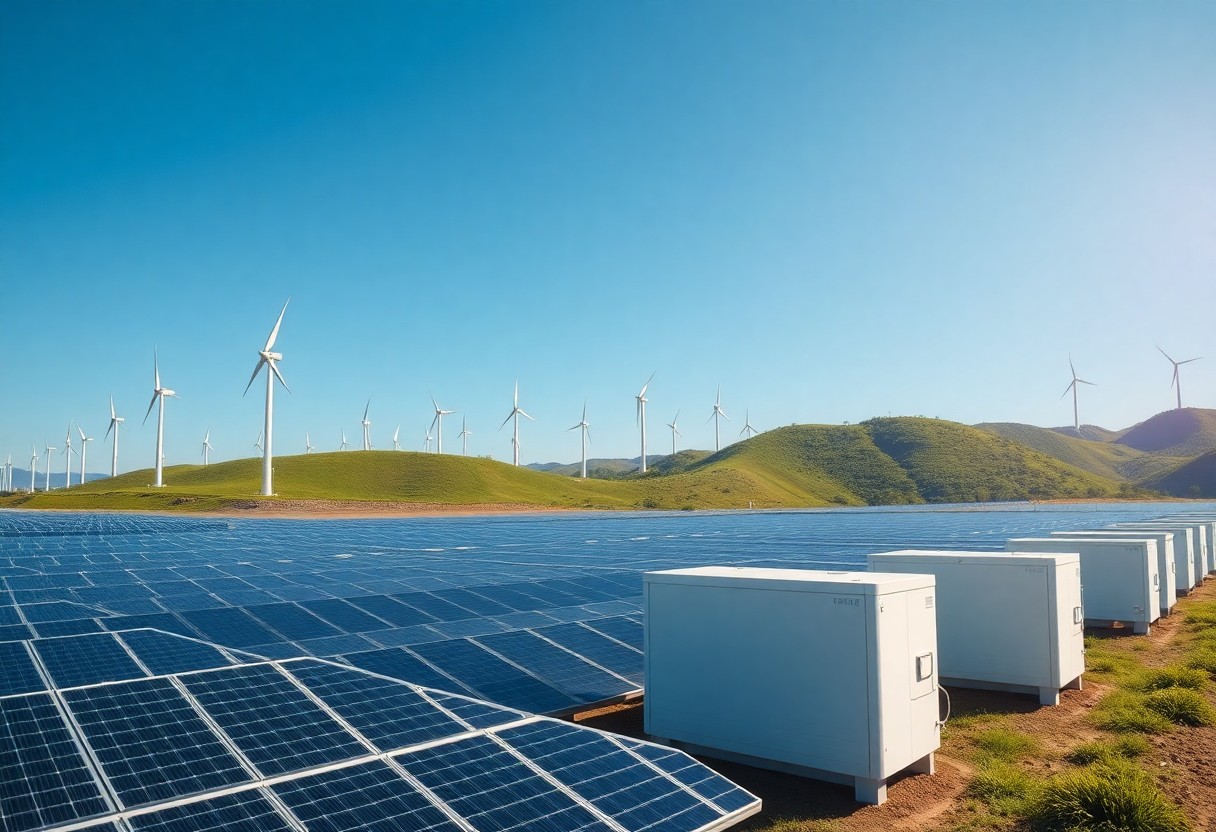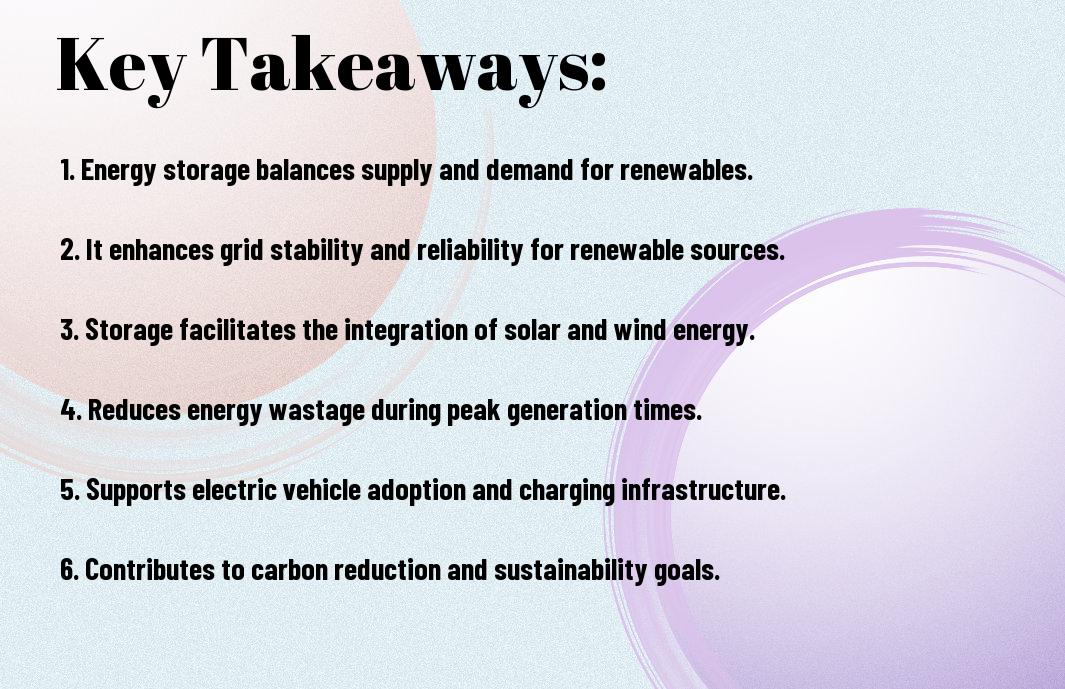Many individuals are becoming increasingly aware of the significance of renewable energy sources, but understanding the role of energy storage in this dynamic landscape is equally important. As you explore renewable power options, consider how energy storage solutions—such as batteries and pumped hydro—facilitate a more reliable and efficient energy system. These technologies not only help balance supply and demand but also enable you to harness renewable energy when it’s abundant, ensuring you have access to clean power even when the sun isn’t shining or the wind isn’t blowing.
Key Takeaways:
- Energy Storage Systems play a vital role in balancing supply and demand, ensuring energy generated from renewable sources is effectively utilized.
- Grid Stability can be enhanced through energy storage, helping to mitigate fluctuations in renewable energy generation, such as solar and wind.
- Technological Innovation is driving advances in energy storage solutions, with batteries, pumped hydro, and other methods becoming more efficient and cost-effective.
- Environmental Impact is reduced by integrating energy storage with renewable energy, facilitating a cleaner transition away from fossil fuels.
- Policy Support and investment are imperative to expand energy storage infrastructure, making renewable systems more reliable and widely adoptable.
Understanding Energy Storage
The role of energy storage in renewable power is vital for ensuring a stable and reliable energy supply. Energy storage systems provide a mechanism to harness, store, and discharge energy generated from renewable sources. By bridging the gap between energy generation and consumption, these systems enhance grid reliability and facilitate the integration of fluctuating energy resources.
Types of Energy Storage Systems
Beside traditional battery systems, various energy storage technologies exist that you should be familiar with:
| Type | Description |
| Pumped Hydro Storage | Utilizes gravitational potential energy by pumping water uphill to store energy. |
| Battery Storage | Employs electrochemical processes to store energy efficiently. |
| Flywheel Energy Storage | Stores kinetic energy in a rotating mass for quick discharge. |
| Compressed Air Energy Storage | Uses compressed air energy to generate electricity when needed. |
| Thermal Energy Storage | Stores heat for producing electricity or heating purposes later. |
- The effectiveness of each technology varies depending on application.
- Some systems excel in long-term storage, while others are better for short bursts.
- Your choice should align with your specific energy needs.
- Researching your options can lead to substantial savings.
- Thou must evaluate the scalability of storage solutions for future growth.
Mechanisms of Energy Storage
By understanding how energy storage mechanisms work, you can appreciate their importance in managing renewable energy supply. These systems operate through various physical and chemical processes that convert and retain energy effectively.
In fact, mechanisms such as electrochemical reactions in batteries, the physical movement of water in pumped hydro systems, and the compression of air in CAES effectively illustrate how energy can be stored in multiple forms. Each type leverages unique principles, allowing you to select an appropriate system based on your energy requirements. Additionally, advancements in technology are leading to more efficient storage methods, allowing for greater integration of renewable sources into your energy mix.
Importance of Energy Storage in Renewable Energy
Some might underestimate the significance of energy storage in the renewable energy sector, but it plays a vital role in enhancing the reliability and efficiency of energy systems. By balancing supply and demand, energy storage allows you to harness renewable sources effectively, ensuring a consistent energy supply even during fluctuations or periods of low generation. This not only enhances the usability of renewable energy but also contributes to a more sustainable grid, empowering you to make more informed energy choices.
Integration with Solar Power
Energy storage systems serve as a buffer for solar power, enabling you to store excess energy generated during peak sunlight hours and use it when solar output declines. This integration maximizes your solar investment, allowing for greater energy independence and reliability.
Role in Wind Energy
Integration of energy storage with wind energy helps to smooth out the variability associated with wind generation, allowing you to use generated energy more efficiently.
For instance, when wind conditions are favorable and turbines are producing excess energy, you can store that energy for later use during low wind periods. This capability not only enhances the reliability of wind power but also ensures you have access to clean energy around the clock. Additionally, storage systems can help stabilize the grid by providing support during sudden drops in wind generation, making your renewable energy use more dependable and effective.
Benefits of Energy Storage
Now, energy storage systems offer numerous benefits that enhance the efficiency and effectiveness of renewable power sources. By seamlessly storing energy generated during peak production times, these systems ensure that you have a reliable supply, regardless of fluctuations in energy generation. This not only supports a sustainable energy future but also promotes economic viability by stabilizing your energy costs and enabling better management of energy resources.
Enhancing Grid Stability
About energy storage, it plays a significant role in enhancing grid stability by providing backup power during peak demand periods and reducing the need for fossil fuel-based generation. When you store excess energy generated from renewables, it mitigates the risk of grid overload and helps maintain a steady supply, thereby ensuring reliability for your energy needs.
Reducing Energy Costs
Along with enhancing stability, energy storage systems can significantly reduce your energy costs by allowing you to purchase electricity during off-peak hours when rates are lower. This capability enables you to store energy to be used during peak times when prices increase, creating savings and optimizing your energy usage.
Understanding the dynamics of energy pricing can empower you to make informed decisions about storage investments. By strategically utilizing stored energy during high-cost periods, you diminish your reliance on grid power, effectively lowering your overall utility expenses. Moreover, some regions offer incentives or programs that reward you for utilizing energy storage, further enhancing your savings and contributing to a sustainable energy ecosystem.
Challenges and Limitations
After examining the benefits of energy storage in renewable power, it’s important to address the challenges and limitations that may hinder its adoption. These challenges can include technological barriers, economic considerations, and the need for regulatory frameworks. Understanding these obstacles will equip you with the knowledge necessary to navigate the complexities of energy storage solutions effectively.
Technological Barriers
About the technological barriers associated with energy storage, you will find that many current systems face issues like energy density, lifespan, and efficiency. While advances are being made, some storage technologies, such as batteries, continue to deal with constraints that can limit their performance and scalability. Overcoming these barriers is imperative for a seamless integration of energy storage with renewable sources.
Economic Considerations
One of the significant economic considerations in energy storage systems is the initial investment required. The costs of advanced storage technologies can be a hurdle for widespread adoption, making it imperative for you to weigh the long-term benefits against the upfront expenses.
A closer look at the economic implications reveals that while initial investments may be substantial, the return on investment can be favorable in the long run through energy savings, reduced reliance on fossil fuels, and enhanced grid stability. You should consider not only the capital costs but also the potential for government incentives and decreasing technology costs. As economies of scale improve and technology advances, energy storage is likely to become more economically viable, paving the way for increased adoption in renewable power systems.
Future Trends in Energy Storage
Not only is energy storage pivotal for enhancing the viability of renewable power, but it’s also poised for significant evolution. As technology advances and costs decrease, you will find that energy storage solutions, such as batteries and thermal systems, become more integrated with renewable energy systems, enabling more extensive deployment and efficiency. Expect to see innovative applications, like grid-scale storage and residential energy management systems, revolutionizing how you harness and utilize renewable energy.
Innovations and Advancements
To stay ahead in the energy landscape, you should pay close attention to ongoing innovations in energy storage technologies. Developments in solid-state batteries, flow batteries, and even new materials for energy storage promise to enhance performance, increase longevity, and reduce costs. As these advancements take hold, your options for reliable and efficient energy storage will dramatically expand, enabling you to better manage renewable energy supply and demand.
Regulatory and Market Developments
At the heart of the growing energy storage sector are regulatory frameworks and market dynamics that shape its development. You will benefit from supportive policies that incentivize investment in energy storage as well as increasing partnerships between energy providers and storage companies. These developments create a more favorable landscape for innovative storage solutions, paving the way for a cleaner and more resilient energy future.
This landscape is dynamically changing as regulatory bodies recognize the importance of energy storage in achieving sustainability goals. Increasingly, you will see incentive programs, tax credits, and grants aimed at encouraging investment in energy storage solutions. Moreover, market developments are driving competition among providers, leading to improved technologies and lower costs. With these advancements, you can anticipate a more diversified energy portfolio that leverages renewable sources effectively, ensuring that your energy needs are met efficiently and sustainably.

Case Studies
Many real-world implementations of energy storage systems have demonstrated their effectiveness in enhancing the use of renewable energy. Consider the following notable examples:
- Hornsdale Power Reserve, Australia: 150 MW/194 MWh battery system, reducing grid frequency issues and lowering energy costs by over 50%.
- LA’s Beacon Energy Storage: 100 MW/400 MWh, providing backup power and stabilizing the grid while integrating more solar energy.
- AES Clean Energy, Chile: 240 MW lithium-ion battery system, enabling a 20% increase in solar power usage during peak hours.
- Ventures on Battery Storage, Germany: 300 MW systems, facilitating the integration of 50% more renewables into the grid without compromising reliability.
Successful Energy Storage Implementations
About multiple projects, your attention should be drawn to successful energy storage implementations that exemplify the power of these technologies. For instance, the Tesla Powerpack in South Australia significantly improved reliability and reduced costs, while the Hydro Store project in the UK demonstrated how compressed air energy storage can support renewable integration. These practical examples showcase your potential for deploying energy storage in various environments to enhance renewable power capabilities.
Lessons Learned
By examining the outcomes of various energy storage implementations, you can glean important insights and experiences formulated through trials and successes. The projects illustrate the need for adjustable systems to adapt to changing energy demands and the value of collaboration across sectors to optimize technology utilization.
Even as you explore the lessons learned from these case studies, it becomes clear that flexibility, partnership, and careful planning are important for realizing the full potential of energy storage in renewable energy systems. Analyzing failures and successes alike can guide you in making informed decisions moving forward, ensuring that your investments in energy storage yield lasting benefits for future sustainability.

Final Words
As a reminder, energy storage plays a significant role in enhancing the reliability and efficiency of renewable power sources. By integrating storage solutions, you can ensure a steady supply of energy, even during fluctuations in production. This not only optimizes the performance of renewable technologies but also empowers you to reduce reliance on traditional energy grids. Understanding and implementing energy storage can greatly benefit your transition to a sustainable energy future, making it a key component in maximizing the potential of renewable resources.
Q: What is energy storage and why is it important for renewable power sources?
A: Energy storage refers to the capture of energy produced at one time for use at a later time. It plays a significant role in renewable energy systems, especially with intermittent sources like solar and wind. Renewable power often generates electricity when demand is low and may not always align with peak usage times. Energy storage systems, such as batteries or pumped hydro storage, help to smooth out the supply, ensuring that energy is available when needed and reducing reliance on fossil fuel power plants.
Q: How do different types of energy storage systems support renewable energy integration?
A: Various energy storage technologies exist, each with unique advantages that facilitate the integration of renewable energy. Battery energy storage systems (BESS) are widely used for short- to medium-term storage, providing real-time grid support and grid stability. Pumped hydro storage is effective for large-scale energy storage and can store energy over longer periods. Thermal energy storage, such as molten salt systems, can store heat energy generated by solar thermal power plants. Each technology caters to different needs and helps to balance the grid, reducing outages and enhancing reliability.
Q: What are the challenges associated with energy storage and its role in renewable power?
A: While energy storage is vital for harnessing renewable resources efficiently, there are several challenges to consider. High initial costs of storage systems, particularly for advanced battery technologies, can be a barrier. Additionally, the efficiency of converting energy back and forth can lead to energy losses. There are also environmental concerns related to the sourcing of materials for certain storage solutions, such as lithium for batteries. Addressing these challenges is important for expanding the role of energy storage in renewable power and achieving a sustainable energy future.



Recent Comments